A) a deflationary spiral is likely to occur.
B) an inflationary spiral is likely to occur.
C) stagflation is likely to occur.
D) the Phillips Curve is likely to shift inward.
F) All of the above
Correct Answer

verified
Correct Answer
verified
Multiple Choice
With demand-pull inflation in the long-run AD-AS model, there is:
A) a decrease in aggregate demand that eventually increases nominal wages and causes a decrease in the short-run aggregate supply curve.
B) an increase in aggregate demand that eventually increases nominal wages and causes an increase in the short-run aggregate supply curve.
C) an increase in aggregate demand that eventually increases nominal wages and causes a decrease in the short-run aggregate supply curve.
D) an increase in aggregate demand that .eventually increases nominal wages and causes a decrease in the short-run aggregate supply curve.
F) A) and B)
Correct Answer

verified
Correct Answer
verified
Multiple Choice
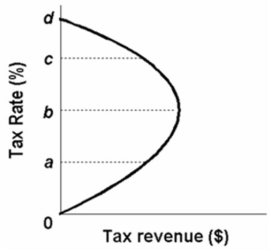 The above diagram describes the notion that as tax:
The above diagram describes the notion that as tax:
A) revenues increase from zero to 100 percent, tax rates will increase from zero to some maximum level and then decline to zero.
B) rates increase from zero to 100 percent, tax revenue will increase from zero to some maximum level and decline to zero.
C) rates decrease from 100 to zero percent, tax revenue will decrease from 100 percent to a maximum level.
D) rates increase from zero to 100 percent, tax revenue will increase from zero to a maximum level.
F) B) and C)
Correct Answer

verified
Correct Answer
verified
True/False
The characteristics of the long-run Phillips Curve suggest that the economy is generally stable at its natural rate of unemployment.
B) False
Correct Answer

verified
Correct Answer
verified
Multiple Choice
In terms of aggregate supply, the difference between the long run and the short run is that in the long run:
A) the price level is variable.
B) employment is variable.
C) real output is variable.
D) nominal wages and other input prices are variable.
F) A) and C)
Correct Answer

verified
Correct Answer
verified
True/False
An ongoing economic growth causes continuous leftward shifts of the aggregate supply which, by themselves, would tend to cause an ongoing deflation.
B) False
Correct Answer

verified
Correct Answer
verified
Multiple Choice
Assuming prices and wages are flexible, a recession will decrease the price level, which:
A) raises nominal wages, and which eventually decreases the short-run aggregate supply curve, thus decreasing real output to its original level.
B) raises nominal wages, and which eventually increases the short-run aggregate supply curve, thus increasing real output to its original level.
C) reduces nominal wages, and which eventually decreases the short-run aggregate supply curve, thus decreasing real output to its original level.
D) reduces nominal wages, and which eventually increases the short-run aggregate supply curve, thus increasing real output to its original level.
F) A) and C)
Correct Answer

verified
Correct Answer
verified
Multiple Choice
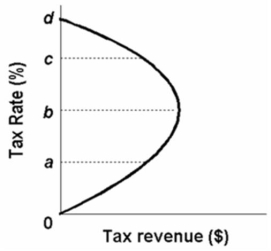 The above curve is known as the:
The above curve is known as the:
A) tax "wedge" curve.
B) Okun Curve.
C) Laffer Curve.
D) Phillips Curve.
F) A) and B)
Correct Answer

verified
Correct Answer
verified
Multiple Choice
A rightward shift of The Phillips Curve would suggest that:
A) the productivity of labour increased.
B) each higher rate of inflation is now associated with a higher rate of unemployment than previously.
C) cost-push inflation decreased.
D) a lower rate of inflation is now associated with each rate of unemployment than previously.
F) B) and C)
Correct Answer

verified
Correct Answer
verified
True/False
When the economy is experiencing cost-push inflation, an increase in aggregate demand will likely result in less inflation.
B) False
Correct Answer

verified
Correct Answer
verified
True/False
In the long run, cost-push inflation results in a simultaneous decrease in the price level and real output.
B) False
Correct Answer

verified
Correct Answer
verified
True/False
If the government attempts to maintain full employment under conditions of cost-push inflation, deflation is likely to occur.
B) False
Correct Answer

verified
Correct Answer
verified
True/False
Based on the long-run Phillips Curve, any particular rate of inflation is compatible in the long run with the natural rate of unemployment.
B) False
Correct Answer

verified
Correct Answer
verified
Multiple Choice
A major adverse aggregate supply shock:
A) automatically shifts the aggregate demand curve rightward.
B) causes the Phillips Curve to shift outward.
C) can be caused by rising productivity.
D) can be caused by falling wages.
F) B) and D)
Correct Answer

verified
Correct Answer
verified
Multiple Choice
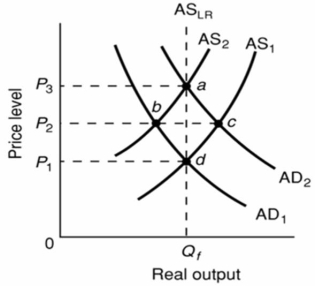 Refer to the above diagram.The initial aggregate demand curve is AD1 and the initial aggregate supply curve is AS1.Cost-push inflation in the short run is best represented as a:
Refer to the above diagram.The initial aggregate demand curve is AD1 and the initial aggregate supply curve is AS1.Cost-push inflation in the short run is best represented as a:
A) leftward shift of the aggregate supply curve from AS1 to AS2.
B) rightward shift of the aggregate demand curve from AD1 to AD2.
C) move from d to b to a.
D) move from d directly to a.
F) A) and B)
Correct Answer

verified
Correct Answer
verified
Multiple Choice
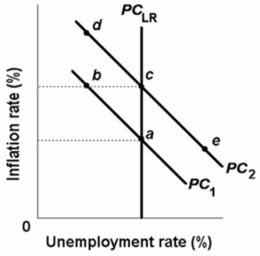 Refer to the above diagram.The move of the economy from c to e on short-run Phillips Curve PC2 would be explained by an:
Refer to the above diagram.The move of the economy from c to e on short-run Phillips Curve PC2 would be explained by an:
A) increase in aggregate demand in the economy.
B) increase in aggregate supply in the economy.
C) actual rate of inflation that is less than the expected rate.
D) actual rate of inflation that exceeds the expected rate.
F) A) and C)
Correct Answer

verified
Correct Answer
verified
Multiple Choice
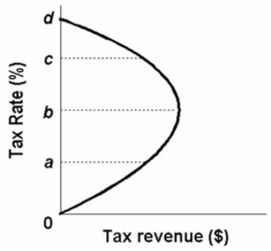 Refer to the above diagram.If tax rates are between b and d, then supply-side economists are of the opinion that a(n) :
Refer to the above diagram.If tax rates are between b and d, then supply-side economists are of the opinion that a(n) :
A) increase in tax revenues will increase tax rates.
B) decrease in tax rates will increase tax revenues.
C) increase in tax rates will increase tax revenues.
D) decrease in tax revenues will decrease tax rates.
F) All of the above
Correct Answer

verified
Correct Answer
verified
Multiple Choice
The basic problem portrayed by the Phillips Curve is:
A) that a level of aggregate demand sufficiently high to result in full employment may also cause inflation.
B) that changes in the composition of total labor demand tend to be deflationary.
C) that unemployment rises at the same time the general price level is rising.
D) the possibility that automation will increase the level of noncyclical unemployment.
F) C) and D)
Correct Answer

verified
Correct Answer
verified
Multiple Choice
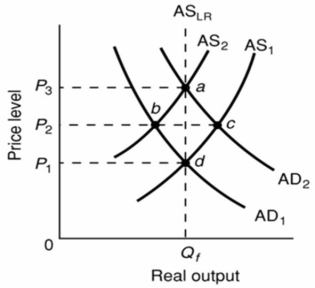 The initial aggregate demand curve is AD1 and the initial aggregate supply curve is AS1.In the long run, the aggregate supply curve is vertical in the diagram because:
The initial aggregate demand curve is AD1 and the initial aggregate supply curve is AS1.In the long run, the aggregate supply curve is vertical in the diagram because:
A) nominal wages and other input prices are assumed to be fixed.
B) real output level Qf is the potential level of output.
C) price level increases produce perfectly offsetting changes in nominal wages and other input prices.
D) higher than expected rates of actual inflation reduce real output only temporarily.
F) B) and C)
Correct Answer

verified
Correct Answer
verified
Multiple Choice
If prices and wages are flexible, a recession arising from a decrease in aggregate demand will:
A) decrease the price level.
B) increase the price level.
C) increase the interest rate.
D) increase net exports.
F) A) and C)
Correct Answer

verified
Correct Answer
verified
Showing 81 - 100 of 122
Related Exams